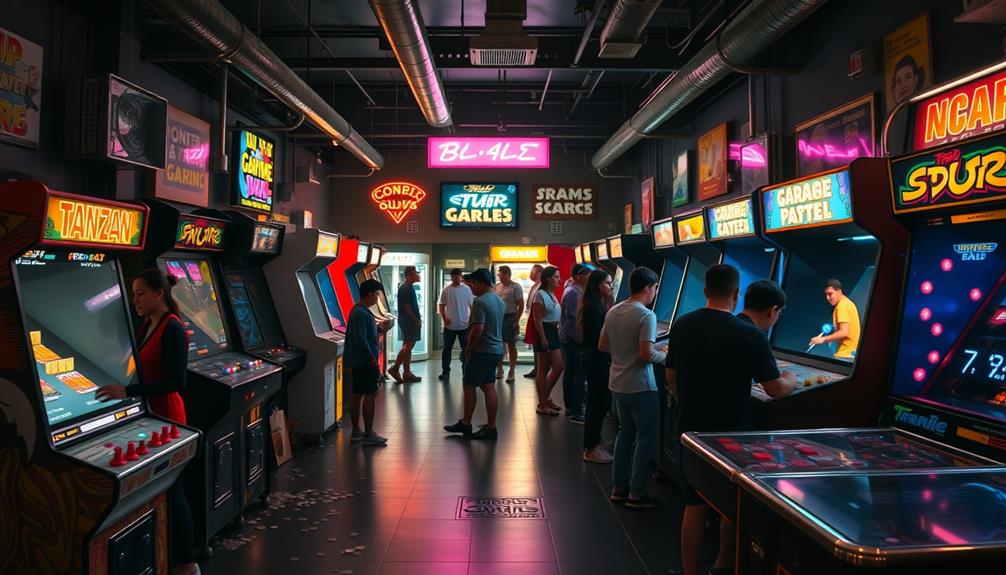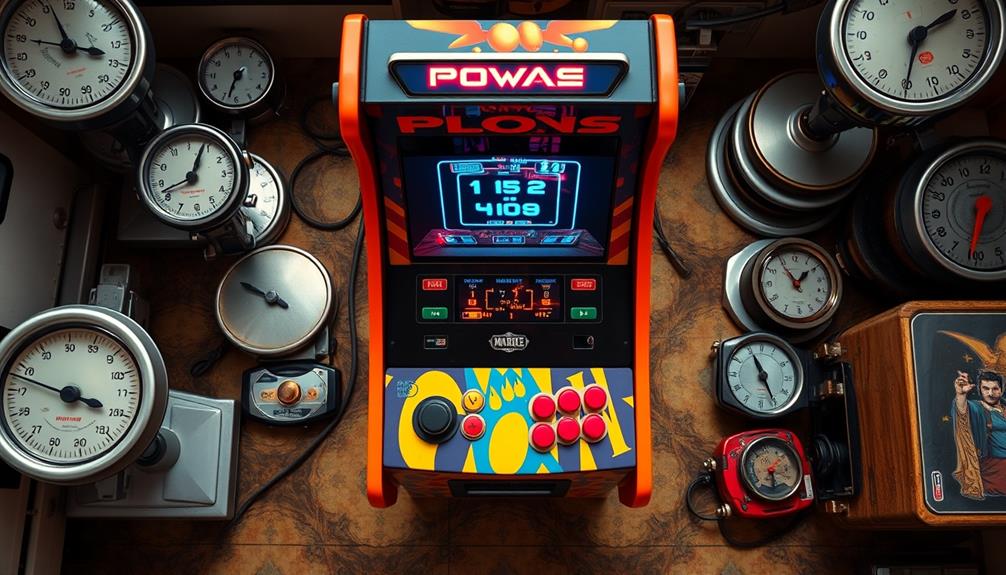Nintendo released a total of 42 arcade games, starting with Computer Othello in 1978. This marked the beginning of their influential presence in the arcade industry in the late 70s and early 80s. Iconic titles such as Donkey Kong and Mario Bros. solidified their reputation, introducing innovative gameplay and lovable characters. Their focus shifted to home consoles in 1985, signifying a significant change in direction. The final arcade game they put out was VS. Dr Mario in 1990, marking the end of their dedicated arcade production. However, the lasting impact of their games can still be felt today. Delve deeper into Nintendo’s arcade history and discover more about their enduring legacy.
Key Takeaways
- Nintendo developed a total of 42 arcade games from 1978 to 1990.
- The first arcade game released by Nintendo was Computer Othello in 1978.
- Notable titles include Donkey Kong, Mario Bros, and Punch-Out!!.
- The last original arcade game produced was VS. Dr Mario in 1990.
- Nintendo's arcade legacy significantly influenced the gaming industry and culture.
Overview of Nintendo's Arcade History
Nintendo's arcade history spans over a decade, beginning in 1978 with the release of Computer Othello. During this period, you witnessed the birth of a gaming powerhouse that would eventually redefine the industry.
Nintendo developed a total of 42 arcade games, showcasing their innovative approach and creativity. The company produced unique arcade titles until 1985, when they shifted focus toward home consoles, recognizing the growing demand for gaming at home. This change echoed trends seen in other entertainment sectors, such as the evolving dynamics of celebrity relationships that highlight adaptability and change.
In those years, you could find Nintendo's arcade games enchanting players with their engaging mechanics and memorable characters. The company experimented with various genres, creating a blend of fun and challenge that kept gamers coming back for more.
This era established Nintendo as a significant player in the arcade scene, setting the stage for their future success.
The last arcade game Nintendo produced was VS Dr Mario in 1990, marking the end of an influential chapter. While their focus may have altered, the impact of these arcade games still resonates today, reminding you of a time when Nintendo was at the forefront of arcade entertainment.
Notable Arcade Titles by Nintendo

When you think about Nintendo's impact on arcade gaming, several iconic titles come to mind.
Games like "Donkey Kong" and "Punch-Out!!" not only showcased innovative gameplay but also highlighted the importance of diversification in gaming genres, appealing to a wide range of players.
These titles left a lasting cultural mark, shaping the industry and influencing future gaming experiences.
Let's explore how these notable releases shaped the industry and influenced future gaming experiences.
Iconic Game Releases
The creativity and innovation of arcade gaming reached new heights with several iconic releases from Nintendo. You might remember Nintendo's first arcade game, Computer Othello, which debuted in 1978 and marked the company's entry into this vibrant industry.
However, it was titles like Donkey Kong (1981) and Mario Bros. (1983) that truly defined Nintendo's arcade legacy, showcasing a radiant and heartwarming vibe that engaged players. These games not only set new standards for gameplay but also revolutionized character design, making them unforgettable.
Punch-Out!! (1983) further distinguished itself from other boxing games with its unique approach, becoming a beloved classic in the arcade scene.
Then, in 1986, VS. Super Mario Bros. hit the arcade, bringing cooperative multiplayer gameplay to the forefront and allowing friends to join forces in the exhilarating experience of platforming.
As arcade gaming evolved, Dr. Mario (1990) emerged as one of the last major arcade titles from Nintendo before the company shifted its focus primarily to home consoles.
Each of these iconic releases contributed greatly to the arcade landscape, leaving a lasting legacy that continues to influence game design today.
Innovative Gameplay Mechanics
Revolutionizing gameplay mechanics, Nintendo's arcade titles have consistently pushed the boundaries of what games can achieve. *Donkey Kong* was a game-changer in 1981, introducing platforming elements and storytelling that captivated players. This innovative approach set the stage for future arcade games, making narrative a key component of gameplay.
Additionally, the incorporation of AI-driven platforms in modern gaming reflects a growing trend towards personalized experiences, much like Nintendo's early focus on engaging gameplay.
In 1983, *Punch-Out!!* brought a unique experience with its dual-screen setup, requiring you to learn your opponents' patterns to achieve victory. This focus on strategy added depth to the arcade fighting genre.
The same year, *Mario Bros.* introduced cooperative multiplayer gameplay, allowing you and a friend to team up against enemies, which paved the way for future multiplayer arcade games.
Fast forward to 1990, and *Dr. Mario* showcased Nintendo's knack for blending genres, combining puzzle-solving with action elements to create engaging gameplay that appealed to a broad audience.
The *VS. Series*, including titles like *VS. Super Mario Bros.*, emphasized competitive play and high score challenges, ensuring that players remained engaged and motivated.
Cultural Impact and Legacy
Nintendo's arcade games have made a significant cultural impact, shaping not just the gaming industry but also popular culture as a whole. With 42 notable titles, Nintendo arcade games like Donkey Kong, Punch-Out!!, and Mario Bros. have left an indelible mark.
Donkey Kong, released in 1981, was a breakthrough for the company, introducing iconic characters like Mario and laying the groundwork for future franchises. This game showcased innovative design that would influence best arcade machines for home game rooms, emphasizing the importance of engaging gameplay.
Punch-Out!!, arriving in 1983, showcased Nintendo's innovation with unique gameplay mechanics that captivated players, making it a beloved boxing game.
Meanwhile, Mario Bros. revolutionized multiplayer gaming by allowing two players to cooperate, a novel concept at the time that set the stage for future cooperative experiences. The arcade adaptation of Super Mario Bros. in 1986 demonstrated Nintendo's skill in converting successful home console titles into the arcade domain, further solidifying its legacy.
These titles not only defined an era of gaming but also influenced countless developers and shaped the trajectory of arcade design. Overall, Nintendo arcade games have established a cultural legacy that continues to resonate with gamers and enthusiasts around the world.
Transition From Arcades to Consoles

As arcade gaming began to wane in popularity, Nintendo recognized the need to adapt and shifted its focus toward home consoles in the late 1980s. They started developing iconic titles for systems like the NES and SNES, marking a significant change in their gaming strategy. The last original arcade game developed by Nintendo was VS Dr Mario, released in 1990, which signified the end of dedicated arcade production.
By the early 1990s, Nintendo's arcade division effectively closed, reallocating resources to home gaming systems. This shift was driven by the rise of home consoles and advancements in technology, which contributed to a decline in arcade popularity during the 1990s. Yet, Nintendo's legacy in arcade games didn't disappear; instead, it thrived through adaptations of their arcade titles into successful home console games.
| Year | Notable Arcade Game | Changed Console Title |
|---|---|---|
| 1985 | Super Mario Bros. | Super Mario All-Stars |
| 1990 | VS Dr Mario | Dr. Mario |
| 1991 | Donkey Kong Country | Donkey Kong Country 2 |
| 1993 | N/A | Super Mario 64 |
This adaptability kept their influence alive in the gaming industry.
Production Trends of Arcade Games

When you explore the production trends of Nintendo arcade games, you'll notice a stark contrast between the classic era and the post-crash period.
During those early years, titles like Donkey Kong saw massive production runs, while many later games became scarce, often limited to just a few hundred units.
This scarcity can be likened to the rarity of certain best rated pinball machines that enthusiasts seek out, highlighting the impact of market changes on game availability and collectibility.
Understanding these shifts helps highlight the impact of market changes on game availability and collectibility.
Classic Era Production Numbers
The classic era of arcade gaming saw manufacturers churning out impressive production numbers, with many titles exceeding 40,000 units. Companies like Atari and Williams dominated the market, consistently producing thousands of units per game. However, smaller manufacturers often had much lower production runs, sometimes only in the hundreds or tens.
A standout during this era was Nintendo's iconic Donkey Kong, which became a cornerstone of arcade gaming. The production numbers for Donkey Kong approached an impressive 80,000 units, showcasing Nintendo's ability to tap into the arcade craze.
Here's a quick comparison of notable arcade game production numbers:
| Game Title | Estimated Production Units |
|---|---|
| Defender | 50,000 |
| Donkey Kong | 80,000 |
| Pac-Man | 100,000 |
| Space Invaders | 60,000 |
After the crash in 1984, the industry saw a dramatic decline, with most games produced between 1985 and 1986 running around 1,000 or fewer units. This shift contributed greatly to the rarity of arcade games in later years, making classics like Donkey Kong more sought after.
Rarity of Games
Rarity in arcade games has become a fascinating aspect of gaming culture, particularly when you look at production trends over the decades. In the classic era, Nintendo's arcade games boasted impressive production numbers, with many titles exceeding 40,000 units before the industry crash in 1984. Games like Donkey Kong were produced in staggering quantities, close to 80,000 units, making them relatively common.
This period also saw the emergence of innovative gameplay mechanics, which set the stage for future gaming experiences. However, after 1984, the landscape changed dramatically. The production of arcade games considerably declined, with most mid-1980s titles seeing runs of about 1,000 units or less.
This shift resulted in a stark contrast between older and newer games. While classics enjoyed mass production, contemporary releases often became rare collectibles. The production figures for arcade games are derived from various sources, including company records and serial numbers, leading to estimates that can vary considerably.
Notable games such as Defender and Joust had production runs of about 50,000 and between 40,000 to 60,000 units, respectively. This disparity highlights how the rarity of games can impact their value and desirability in the arcade gaming community, similar to the historical significance of early pinball machines in the pinball industry.
Notable Game Production Figures
Nintendo's production of arcade games reveals a compelling narrative about the evolution of the industry. With a total of 42 titles, Nintendo's lineup includes classics like Donkey Kong, Punch-Out!!, and Mario Bros., which have become cornerstones of arcade gaming.
During the classic era of arcade games, prior to 1984, production figures soared, with some titles exceeding 40,000 units. This trend showcased the fierce competition among major companies, where Nintendo stood out. Their innovative approach is similar to strategies seen in the precious metals market, where companies like Noble Gold Review emphasize educational resources for investors.
However, post-1984, the landscape changed dramatically due to the industry crash. You'd notice that production numbers plummeted, with most games averaging around 1,000 units or less. This stark contrast emphasizes the challenges Nintendo faced.
Yet, their notable production figures tell a different story—Donkey Kong alone boasted approximately 80,000 units, a clear indication of its popularity during the arcade boom.
When comparing Nintendo vs. other companies, it becomes evident that Nintendo's ability to adapt and innovate has kept them relevant, even as the number of new arcade titles dwindled. Their production trends not only reflect their success but also highlight the broader patterns in the arcade gaming industry.
Key Collaborations and Partnerships

Collaborations and partnerships have played an essential role in shaping Nintendo's arcade game offerings. One of the most notable partnerships was with Midway Games. Together, they co-developed several remarkable arcade titles, enhancing the quality and innovation of Nintendo's gaming catalog. This collaboration resulted in unique arcade experiences that integrated original gameplay mechanics with popular franchises, allowing players to engage in fresh and exciting ways.
Additionally, these efforts reflect the importance of utilizing feedback collection to understand player preferences and enhance game design. Nintendo didn't stop there; they also partnered with various third-party developers to expand their arcade game library. By collaborating with these external studios, Nintendo introduced diverse titles and genres that appealed to a broader audience. These efforts were essential in enhancing player engagement and gameplay variety, which greatly impacted the popularity of arcade games during the 1980s and 1990s.
Through these joint efforts, Nintendo and its partners contributed to shaping the arcade gaming landscape. The foundation laid during this period not only set the stage for future gaming innovations but also established Nintendo as a key player in the industry. With these collaborations, players enjoyed a richer arcade experience, ensuring Nintendo's legacy in arcade gaming endures.
Impact of Third-Party Developers

The influence of third-party developers on Nintendo's arcade game offerings can't be overstated. These collaborations expanded Nintendo's library and brought unique experiences that kept players engaged. By working with various developers, Nintendo welcomed a diverse range of titles that not only featured Mario but also introduced fresh concepts that captivated a broader audience.
This approach mirrors how different brewing methods in coffee can lead to varying flavor profiles and experiences, enhancing the overall enjoyment of the product, just like various brewing methods impact coffee's caffeine content.
- Enhanced gameplay variety through innovative mechanics
- Increased popularity of arcade games in the 1980s
- Iconic character integration enriching the gaming ecosystem
These partnerships allowed Nintendo to incorporate beloved franchises and original ideas, greatly impacting the arcade gaming landscape. During the 1980s, third-party contributions played a vital role in establishing Nintendo as a key player in the industry.
Games featuring Mario alongside inventive gameplay mechanics drew players into arcades, creating a vibrant gaming culture. Through these collaborations, Nintendo set the stage for future game development, influencing how arcade games evolved.
The synergy between Nintendo and third-party developers guaranteed that players experienced a rich tapestry of gaming, combining nostalgia with innovation. Ultimately, this collaboration laid the groundwork for the enduring legacy of Nintendo in arcade gaming.
Cultural Significance of Arcade Games

Arcade games have carved a significant niche in gaming culture, especially during the early 1980s when titles like Donkey Kong emerged as groundbreaking successes. Nintendo's arcade games didn't just entertain; they revolutionized the gaming landscape.
Games like Punch-Out!! and Mario Bros. set the stage for future console titles, influencing gameplay mechanics and character design that still resonate today.
You likely remember the excitement of playing in arcades, where social gaming thrived. Players gathered in public spaces, competing for high scores and sharing their experiences. This communal aspect fostered a vibrant culture around gaming, establishing connections that many still cherish.
Nintendo's innovative designs in arcade games also pushed the envelope of gaming technology. Features introduced in these games often found their way into home consoles, paving the way for the evolution of gaming as it's understood.
The legacy of Nintendo's arcade games continues to resonate today, with a revival of interest in retro gaming and ongoing remakes of classics like Super Mario. Their impact on gaming culture is undeniable and continues to inspire new generations of players.
Rarity and Collectibility of Titles

As players reminisce about their favorite arcade experiences, the rarity and collectibility of Nintendo's titles become a point of fascination for enthusiasts and collectors alike.
With 42 arcade games produced, some, like Donkey Kong and Super Mario Bros., are iconic and widely available, while newer titles tend to be scarce. The production numbers tell a compelling story: classic games often exceeded 40,000 units, but those released post-1984 usually had runs of 1,000 or fewer, considerably impacting their rarity.
Consider these key aspects of collectibility:
- Production Numbers: Fewer units mean higher rarity and demand among collectors.
- Preservation: Older arcade machines are often well-preserved, but limited releases of newer titles can be harder to find.
- Unique Examples: Machines like Shark JAWS, with fewer than 500 units made, are highly sought after due to their extreme rarity.
This combination of factors has created a thrilling landscape in the world of Nintendo arcade games, compelling collectors to chase after elusive titles that evoke nostalgia and excitement.
Frequently Asked Questions
How Many Games Did Nintendo Create?
You'll find that Nintendo's creativity shines through countless games across various platforms. While exact numbers vary, they've released hundreds, each contributing to gaming history and your enjoyment, showcasing their innovative spirit and dedication to fun.
Did Nintendo Make Arcade Games?
Yes, Nintendo made arcade games! Starting in 1978, they developed a variety of iconic titles. Their unique arcade offerings helped shape the gaming industry and laid the groundwork for many beloved console franchises we enjoy today. In 1980, Nintendo released their first game that featured the character Donkey Kong, which became a massive hit and helped to further solidify their place in the arcade game industry. This pivotal moment marked the evolution of arcade games in 1980 and set the stage for the future success of Nintendo’s gaming empire. Their innovative gameplay and creative design paved the way for the modern era of gaming, and their contributions continue to inspire game developers to this day.
What Was Nintendo's First Big Game Hit in Arcades?
Imagine a pixelated hero climbing to greatness—Nintendo's first big hit in arcades was "Donkey Kong." Released in 1981, it introduced Mario and revolutionized gaming with its enchanting story and multi-level challenges. You'd love it!
How Many Games Did Super Nintendo Make?
The Super Nintendo Entertainment System boasts an impressive library of over 700 games. You'll find iconic titles like Super Mario World and The Legend of Zelda: A Link to the Past among its diverse offerings.
Conclusion
In conclusion, Nintendo's remarkable roster of arcade games reflects a rich legacy that shaped gaming culture. From thrilling titles to timeless classics, their impact is undeniable. As you explore their arcade adventures, you'll discover a delightful blend of creativity and collaboration that captivated countless players. Though they shifted to consoles, the echoes of those early experiences linger. So, whether you're a collector or a casual fan, Nintendo's arcade gems offer unforgettable fun and fond memories.









